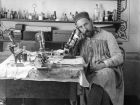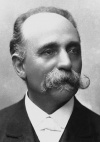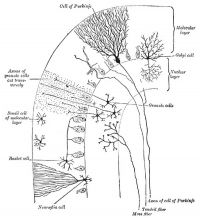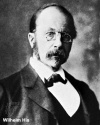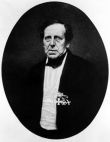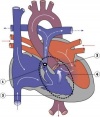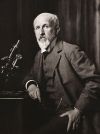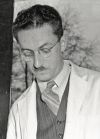Historic Embryology Vignette
| Embryology - 27 Apr 2024 |
|---|
| Google Translate - select your language from the list shown below (this will open a new external page) |
|
العربية | català | 中文 | 中國傳統的 | français | Deutsche | עִברִית | हिंदी | bahasa Indonesia | italiano | 日本語 | 한국어 | မြန်မာ | Pilipino | Polskie | português | ਪੰਜਾਬੀ ਦੇ | Română | русский | Español | Swahili | Svensk | ไทย | Türkçe | اردو | ייִדיש | Tiếng Việt These external translations are automated and may not be accurate. (More? About Translations) |
Introduction
This page shows the brief historic vignettes that appear on various notes pages introduction and other sections. These are intended to give some historic background to Embryology. These can also appear as a collapsible table.
The links shown below are to full versions of historic embryology textbooks and papers.
| Historic Disclaimer - information about historic embryology pages |
|---|
| Pages where the terms "Historic" (textbooks, papers, people, recommendations) appear on this site, and sections within pages where this disclaimer appears, indicate that the content and scientific understanding are specific to the time of publication. This means that while some scientific descriptions are still accurate, the terminology and interpretation of the developmental mechanisms reflect the understanding at the time of original publication and those of the preceding periods, these terms, interpretations and recommendations may not reflect our current scientific understanding. (More? Embryology History | Historic Embryology Papers) |
Assisted Reproductive Technology
| Historic Embryology |
|
The Nobel Prize in Physiology or Medicine 2010 - Awarded to Robert G. Edwards (1925-2013) "for the development of in vitro fertilization" who battled societal and establishment resistance to his development of the in vitro fertilization procedure, which has so far led to the birth of around 4 million people. (More? Assisted Reproductive Technology | Nobel Prize 2010) 10 April 2013 - Sir Robert Edwards has died aged 87. BBC News |
Cerebellum
| Historic Embryology | ||||
Much of the basic structure of the cerebellum comes the historic histological studies and staining of Ramón Cahal (1852 - 1934) and Camillo Golgi (1843 - 1926). Cahal was a Spanish researcher who used the then new histology Golgi staining techniques to identify the cerebellum cellular structure. His work was a turning point in our understanding of the structure of the brain, that until then had been described as a "syncytium" and not consisting of discrete cellular elements. For this research and other work on defining the structure of the brain he, along with Camillo Golgi (1843 - 1926), received the 1906 Nobel Prize in Medicine.
| ||||
| Historic Embryology |
|
During the 1940's to 50's Olof Larsell (1886-1964) in the USA described cerebellum development in several species[1][2][3][4][5][6], including man.[7][8] He also organized the terminology for the lobes and lobules of the cerebellum. Larsell was a professor and chair of anatomy at the University of Oregon Medical School. |
Corpus Luteum
| Historic Embryology |
|
Regnier de Graaf (1641 – 1673) first observed histologically the corpus luteum in the ovary of a cow by its defining yellow structure. The yellow colour is caused by the accumulation of steroidal hormones.
|
Ductus Deferens
| Historic Embryology |
|
Caspar Friedrich Wolff (1734-1794) was a German embryologist and anatomist best known today for identifying the Wolffian duct (mesonephric duct; ductus deferens, epididymis), Wolffian body (mesonephros) and Wolffian cyst (mesonephric origin uterine broad ligament cyst) that bear his name. Thought also to be a founder of the germ layer theory. His doctorate dissertation Theoria generationis (1774) discarded the developmental theory of preformation. Later in his career, his teaching in Berlin was opposed by the professors of the Medical-Surgical College, who had guild privileges to teach medicine. |
Gastrulation
| Historic Embryology |
|
Hans Spemann (1869 - 1941) identified this region in amphibia, also called the "Spemann's organiser". The same region in birds it is known as "Hensen's node" named for Victor Hensen (1835 – 1924) and is also known generally as the primitive node or knot. In humans, it is proposed that similar mechanisms regulate gastrulation to those found in other vertebrates. Currently, the molecular and physical mechanisms that regulate patterning and migration during this key event are being investigated in several different animal models. |
Guthrie Test
| Historic Embryology |
|
Dr Robert Guthrie (1916-1995) was an American microbiologist at University of Buffalo who developed the collection of whole blood on filter paper "Guthrie cards" for transportation, storage, and testing for metabolic and genetic disorders of the newborn. The test today also has a number of names: "heel prick", "neonatal blood" test, and dried-blood spots. Guthrie is best known for developing the diagnostic test for phenylketonuria. |
Liver
| Historic Embryology |
|
Marcello Malpighi (1628 – 1694) was an Italian biologist and physician who in 1666 first named the liver lobules - "the livers of all vertebrates are conglomerate glands, being composed of lobules which in turn contain acini". He is also known for structures that bear his name in the spleen Malpighian bodies (white pulp) and renal Malpighian corpuscle (renal corpuscle). See also Mall's 1906 Liver Historical Note |
Lymphatic
| Historic Embryology |
|
Florence Rena Sabin (1871-1953) was an early USA researcher of the embryological development of the lymphatic system. She studied human embryos (from the Carnegie Collection) and used injected ink studies of the pig embryo, A 1912 textbook chapter on "The Development of the Lymphatic System" was one of the earliest reviews of this system. |
Male Genital
| Historic Embryology |
|
Caspar Friedrich Wolff (1734-1794) was a German embryologist and anatomist best known today for identifying the Wolffian duct (mesonephric duct; ductus deferens, epididymis), Wolffian body (mesonephros) and Wolffian cyst (mesonephric origin uterine broad ligament cyst) that bear his name. Thought also to be a founder of the germ layer theory. His doctorate dissertation Theoria generationis (1774) discarded the developmental theory of preformation. Later in his career, his teaching in Berlin was opposed by the professors of the Medical-Surgical College, who had guild privileges to teach medicine. |
| Historic Embryology |
| Johannes Peter Müller (1801 - 1858) in 1830 was the first to describe the female genital duct that develops as the uterus and vagina, historically named after him as the "Müllerian duct". The current terminology is the "paramesonephric duct".
Alfred Jost (1916-1991), a French endocrinologist researcher, first discovered in 1947 Anti-Mullerian Hormone he used a rabbit model to identify this hormone as responsible for Müllerian duct (paramesonephric duct) regression during fetal rabbit development. His findings explained several abnormalities of sexual development. This included the "freemartin calf", that acquires AMH from a male twin in utero generating an infertile female with masculinized behavior and non-functioning ovaries. |
Neural Crest
| Historic Embryology |
|
Arthur Milnes Marshall (1852–1893) at Cambridge in 1879 historically first described this embryonic region. In his study of dogfish and chicken brain development, and identified it as "neural crest".[9] See neural crest history and the original 1879 article. Wilhelm His (1831-1904) in 1868 also described in the chick embryo the early neural structure that would form neural crest. |
Ovary
| Historic Embryology |
| Regnier de Graaf (1641 – 1673) was a Dutch anatomist and physician who described the anatomy of the uterine tube and the development of follicles in the ovary. He was first to describe the "Graafian follicle" (preovulatory follicle) in the ovary of mammals, but erroneously believed the entire follicle to be the mammalian oocyte (egg). |
Pituitary
| Historic Embryology |
| During pituitary development, the boundary surface ectoderm placode epithelium on the roof of the pharynx forms a transient epithelial pocket (Rathke's pouch) that comes into contact with the ectoderm of developing brain.
|
Schwann Cell
| Historic Embryology |
| Theodor Schwann (1810 - 1882), was a German physiologist and the first to discover the "Schwann cell" in the peripheral nervous system. He was also, along with Matthias Jakob Schleiden (1804-1881), in 1838 the developer of the "cell theory". |
Spleen
| Historic Embryology |
|
The Malpighian bodies or Malpighian bodies of the spleen is the historic name for spleen white pulp or splenic lymphoid nodules. Named after Marcello Malpighi (1628 – 1694) an Italian biologist and physician. A spleen lymphoid region, organized as lymphoid sheaths with both T-cell and B-cell compartments, around the branching arterial vessels (resembles lymph node structure).
The term should not be confused with the renal structure, a Malpighian corpuscle (renal corpuscle). |
Tetralogy of Fallot
| Historic Embryology |
|
Helen Brooke Taussig (1898 - 1986) on November 9, 1944 Taussig and Blalock first performed a new operation on a Tetralogy of Fallot or "blue baby" and later repeated it successfully on two more patients. The technique was named the Blalock-Taussig operation, and was soon used worldwide. Taussig continued her research on cardiac birth defects and also campaigned for blocking the introduction of thalidomide into the U.S.A. |
Trisomy 21
| Historic Embryology |
| John Langdon Haydon Down (1828-1896) in 1866 first clinically identified the phenotype in patients, that later became known as "Down Syndrome". It was not until 1959, with the development of genetic analysis, that the additional copy of chromosome 21 (Trisomy 21) was identified as the basis of this developmental abnormality. Note that the original paper uses historic terminology that would no longer be considered acceptable in Medicine. |
Tooth
| Historic Embryology |
|
Oscar Hertwig (1849-1922) was a German embryologist and anatomist who first identified in amphibia tooth development, and was subsequently named Hertwig's epithelial root sheath (HERS). In amphibia, this is a permanent structure. In mammals, this is a transient structure, assembled during early tooth root formation and elongation. Later the HERS becomes fenestrated and reduced to the epithelial rests of Malassez (ERM).[10] |
Toxoplasmosis
| Historic Embryology |
| Toxoplasma gondii (toxoplasmosis) was initially described in 1908 in Tunis by Nicolle and Manceaux (1908) and in Brazil by Splendore (1908).[11]
Currently every 3 years experts from many areas meet at the ICOCT – IV "International Congress on Congenital Toxoplasmosis" (last held in 2019 Casa Cava, Italy). |
Uterus
| Historic Embryology |
| Johannes Peter Müller (1801 - 1858) in 1830 was the first to describe the female genital duct that develops as the uterus and vagina, historically named after him as the "Müllerian duct". The current terminology is the "paramesonephric duct". |
X Inactivation
| Historic Embryology |
|
Mary Lyon (1925-2014) was a UK geneticist who proposed in 1961 the theory of X inactivation, where one of the two X chromosomes in the cells of female mammals is randomly inactivated during early development. In deference to her, this process is also referred to as "Lyonisation". She also worked on other X-linked genetic diseases, such as Duchenne muscular dystrophy and haemophilia. |
| Historic Embryology |
|
[Murray L. Barr (1908-1995) was a Canadian researcher who, along with E. Bertram, first identified the inactivated x chromosome (Barr body) as an extension from the nucleus in female cells. "An interesting and useful variant is the study of blood films. In females only, there is an appendage with special characteristics and probably containing the sex chromatin, attached to a lobe of the nucleus in a small proportion of neutrophilic leukocytes."[12] |
References
- ↑ LARSELL O. (1946). The cerebellum of cyclostomes. Anat. Rec. , 94, 478. PMID: 21020604
- ↑ LARSELL O. (1952). The morphogenesis and adult pattern of the lobules and fissures of the cerebellum of the white rat. J. Comp. Neurol. , 97, 281-356. PMID: 12999992 DOI.
- ↑ LARSELL O & WHITLOCK DG. (1952). Further observations on the cerebellum of birds. J. Comp. Neurol. , 97, 545-66. PMID: 13034933 DOI.
- ↑ LARSELL O. (1954). The development of the cerebellum of the pig. Anat. Rec. , 118, 73-107. PMID: 13124788 DOI.
- ↑ LARSELL O. (1948). The development and subdivisions of the cerebellum of birds. J. Comp. Neurol. , 89, 123-89. PMID: 18889711 DOI.
- ↑ LARSELL O. (1947). The cerebellum of myxinoids and petromyzonts including developmental stages in the lampreys. J. Comp. Neurol. , 86, 395-445. PMID: 20239748 DOI.
- ↑ LARSELL O & STOTLER WA. (1947). Some morphological features of the human cerebellum. Anat. Rec. , 97, 352. PMID: 20341845
- ↑ LARSELL O. (1947). The development of the cerebellum in man in relation to its comparative anatomy. J. Comp. Neurol. , 87, 85-129. PMID: 20267600 DOI.
- ↑ Marshall AM. The morphology of the vertebrate olfactory organ. (1879) Quarterly Journal of Microscopic Science. 19: 300–340.
- ↑ Luan X, Ito Y & Diekwisch TG. (2006). Evolution and development of Hertwig's epithelial root sheath. Dev. Dyn. , 235, 1167-80. PMID: 16450392 DOI.
- ↑ Weiss LM & Dubey JP. (2009). Toxoplasmosis: A history of clinical observations. Int. J. Parasitol. , 39, 895-901. PMID: 19217908 DOI.
- ↑ BARR ML. (1956). The sex chromatin and its bearing on errors of sex development. Can Med Assoc J , 74, 419-22. PMID: 13304780
Glossary Links
- Glossary: A | B | C | D | E | F | G | H | I | J | K | L | M | N | O | P | Q | R | S | T | U | V | W | X | Y | Z | Numbers | Symbols | Term Link
Cite this page: Hill, M.A. (2024, April 27) Embryology Historic Embryology Vignette. Retrieved from https://embryology.med.unsw.edu.au/embryology/index.php/Historic_Embryology_Vignette
- © Dr Mark Hill 2024, UNSW Embryology ISBN: 978 0 7334 2609 4 - UNSW CRICOS Provider Code No. 00098G



